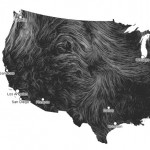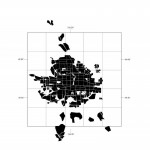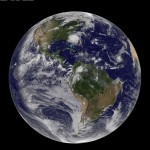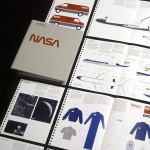When the first images were transmitted from the Landsat 1, only days after the small unmanned satellite was launched in 1972, cartography and Earth sciences were changed forever.
Although a civilian terrestrial remote-sensing satellite was proposed in 1965, it was only in 1970, after hard political struggle, that NASA was given the funding for an Earth Resources Technology Satellite (ERTS). The satellite itself, later renamed Landsat (in 1976), was designed, built and launched in only two years.
Not only Landsat images were used to correct previous geographic and topographic maps (which instantly appeared out of date), but they started being considered maps in themselves, and mosaics of cloud free areas were substantially useful for geologists, hydrologists, oceanographers, agronomists, the military and even for public purposes, as for the iconic 10 × 16 foot map (about 300 x 490 cm) of the United States, composed of 700 mosaics, prepared in time for the National Geographic US Bicentennial.
The Landsat program still generates more 400 images a day through the still orbiting units 5 and 7, equipped with a technology that has been improved over the years, to produce even more detailed maps. A nearly real-time video feed of Landsat 5 or 7 is visible here.
Informations and images via Codex99.
Related: Satellite Imagery.

Minnesota, the UP, Wisconsin, Illinois and Iowa.

Dallas (I–14) – Ft. Worth. 25 Jul 1972

India-Nepal. Mt. Everest is located at T–1. 14 Dec 1972.

The Grand Canyon, 3 May 1973.

Geology of Central California. 1972

Wyoming Mosaic, 1972.

Southern Iran.

NASA 74-H-275

Tony Rossi working on the original map.

Portrait U.S.A., 1976

The Conterminous United States. National Atlas
All images, except the US ones, are from: Short, Nicholas, Lowman, Paul, et. al. Mission To Earth: Landsat Views the World.Washington, D.C.; NASA, 1976 (NASA SP–360). This oversized “coffee-table” book included 400 plates, which are online at the NASA Astrophysics Data System.





We absolutely love your blog and find many of your post’s
to be what precisely I’m looking for. can you offer guest writers to
write content to suit your needs? I wouldn’t mind creating a post or
elaborating on many of the subjects you write with regards to here.
Again, awesome website!
Thanks, but we don’t need guest posting.
FL